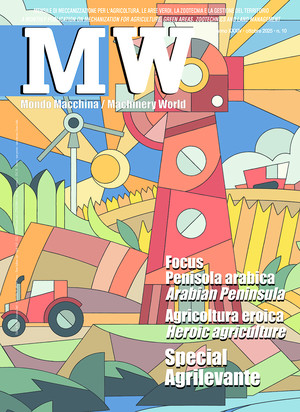
Agricultural machinery, lights and shadows in the European market
The first half of the year, albeit with significant national differences, shows substantial stability in the European tractor market, confirming the high sales volumes seen in the same period last year. In the second half of the year, a drop in demand is expected due to falling farm incomes and reduced 4.0 incentives
European agricultural machinery market closed the first six months of the year with a slight drop in registrations, but without substantially deviating from the volumes of the first half of 2022. Data processed by the European Manufacturers' Committee CEMA on the basis of surveys provided by national associations indicate that total tractor registrations reached 81,155 units, down 1.5% compared to 82,358 in 2022. Even in this first part of 2023 the continental agro-mechanical sector was characterised by a particular liveliness, remaining above pre-pandemic levels. According to analysts, the dynamism recorded in recent months is due to the gradual normalisation of supply chains, which is enabling manufacturers to dispose of outstanding orders in 2021 and 2022.
The geography of European agricultural machinery. The trend in registrations, however, shows significant differences from country to country: on the one hand, countries like Germany, France and the United Kingdom are "going into fourth gear" and improving on their performance in 2022, while on the other, countries like Italy and Spain are slowing down and falling back compared to last year. Going into more detail, Germany sees a 6% increase in tractor registrations (to the tune of 16,597 units) and confirms its position as the locomotive of the continental agro-mechanical sector, narrowly edging out France (16,035 units sold), which nevertheless recorded a 3,6% growth. Positive percentages also for the fourth European market, that of Great Britain, which has registered 7,500 machines since the beginning of the year (+4.9%), while still lagging behind Italy, which has a total of 10,120 registered units. Sales were also down for the other major country in the Mediterranean area, Spain, which recorded a much more consistent contraction (-15.7%), stopping at 4,158 registered tractors. Greece performed in the opposite direction, closing the semester with a striking +73.4%, rising from 425 units in the first half of 2022 to 737 in the current year.
Boom in the Balkans, slowdown in Danube Europe. In the composite European landscape, the boom in the Balkan countries stands out, recording double-digit percentages between January and June, even if referring to smaller sales volumes compared to those of the main European countries. Bosnia Herzegovina is growing strongly: with 703 tractors registered in the first half of 2023, it experienced the largest increase in the entire area (+59.4%), ahead of Croatia (+29.1% with 603 vehicles) and Serbia-Montenegro (+9.2% with 1,252 machines). While the agro-mechanical sector is making significant progress in the Balkan area, in the Danube area it is experiencing a setback. Austria and the Czech Republic saw a drop in sales of 10.6% and 8.7% respectively, the former from 3,028 to 2,707 units, the latter from 1,594 to 1,455. The drop in Slovenia and Hungary was more significant. In the comparison between the two semesters, Slovenia recorded a 16.3% drop (due to 684 registered tractors), while Hungary dropped by 26.3%, stopping at 1,459 registered machines. Poland also fell back (-12.7% to 4,891 tractors) after the peaks reached in the two-year period 2020-2021.
The unknowns of the second half of the year. In the first part of the year, the European tractor market, albeit with the significant differences between countries mentioned above, confirmed the expansionary trend seen since the last months of 2020. Moreover, the slight downturn in 2022, considered as a physiological "pause" after the boom of 2021, did not substantially alter overall sales volumes, which in many cases were higher than pre-Covid. The growing spread of 4.0 farming techniques and investments in latest-generation technologies, also supported by public incentive programmes, have helped drive demand despite the economic and geopolitical context which, as we know, has become problematic following the military conflict in Ukraine. From February 2021 to date, the agro-mechanical market has therefore held up fairly well and yet - analysts warn - the scenario could change during the course of the year. In the short and medium term the sector's performance could be affected by both inflationary pressures on raw materials, transport and services, and by the contraction of agricultural incomes. Up until the first half of 2022 the price increase of many agricultural commodities, due precisely to the military crisis in Ukraine, had allowed operators to compensate to a certain extent for the increase in agricultural input costs. As the emergency phase came to an end and the primary sector gradually "normalised", on the other hand, food prices fell, but not the prices of production factors, leading to a reduction in farmers' purchasing power and spending capacity. Moreover, the propensity to invest in agricultural technology is also weighed down by the progressive exhaustion of public purchase incentive programmes, combined with rising interest rates, which make access to credit more onerous and problematic. In short, the European market could soon find itself experiencing the clear trend reversal that began to be glimpsed in July and August, bringing the 2023 partial to -3%.
The September survey of the Barometer - CEMA's monthly publication that tracks industry sentiment - seems to confirm this change of scenario. The majority of manufacturers - 58% of the sample (the percentage was much lower last July standing at 34%) - believe that their turnover could contract over the next six months. This is a forecast which, like all predictive assumptions, can be corrected in the course of time. Much will depend on the measures that governments might put in place to support an industry sector that is more strategic than ever in the current transition phase of agriculture towards digitisation and high automation.








